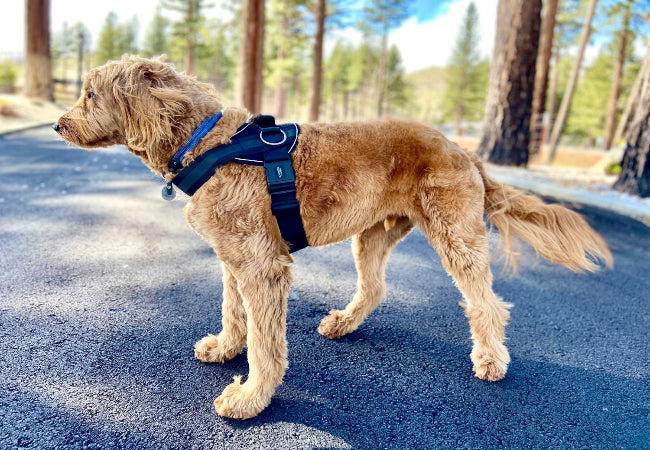Should Puppies Wear Collars or Harnesses? Vet Explains 2025 🐾

In this article
Should Puppies Wear Collars or Harnesses? Vet Explains 2025 🐾
By Dr. Duncan Houston BVSc
Every puppy needs to learn how to walk on a lead—but using the wrong gear early on can lead to injuries, stress, and long-term behavioral problems. That’s why, as a veterinarian and founder of Woopf, I always recommend starting puppies with a properly fitted harness—not a collar.
In this article, I’ll explain the clinical reasons behind that advice, what kind of harness works best, and how to safely start walking your puppy from day one.
🧠 Why Collars Aren’t Safe for Puppies on Lead
Puppy necks are fragile. Until their bones, joints, and trachea mature, even light pressure on the neck can lead to:
- ❌ Tracheal compression (especially in toy breeds)
- ❌ Neck and spinal strain from leash tugs or pulling
- ❌ Increased reactivity due to physical discomfort
Collars are fine for ID tags and indoor use—but they should never be used for leash training a puppy.
🩺 What Vets Recommend Instead
We always suggest using a lightweight, soft, and anatomically supportive harness for puppies. Specifically:
- ✅ Y-front design that avoids armpits and neck
- ✅ Adjustable straps to grow with your puppy
- ✅ Padding for comfort and movement freedom
This lets your pup learn without pain or fear, building trust and good leash habits early on.
🎽 The Ideal Harness for Puppies: Woopf Explorer Harness
The Explorer Harness is used by vets, rescues, and first-time owners because it’s:
- ✔️ Lightweight and breathable
- ✔️ Adjustable in 4 zones for a secure puppy fit
- ✔️ Escape-resistant for nervous dogs or first-time walks
- ✔️ Built for training with a front and back clip
We’ve tested it on Goldens, Staffies, Cavoodles, Dachshunds, and dozens of shelter puppies. It’s the harness I put on my own dog, Kiko, during her first walks.
📚 Research-Backed Reasons to Use a Harness
According to studies in PubMed and veterinary journals:
- Harnesses reduce tracheal pressure and cervical spine load in growing dogs
- Puppies trained in harnesses are less likely to develop leash reactivity
- Improper pressure on the neck can disrupt natural gait and behavior
🧠 Common Puppy Walking Mistakes to Avoid
- ❌ Using a collar as the only lead point
- ❌ Starting with long walks too soon
- ❌ Ignoring signs of harness discomfort or poor fit
- ❌ Using retractable leashes or heavy gear too early
🎯 How to Start Puppy Leash Training (With Woopf Gear)
-
Step 1: Let your puppy sniff the harness. Clip it on indoors for 1–2 minutes.
-
Step 2: Use high-value treats and short, positive sessions.
-
Step 3: Add a lightweight lead (Sealskin Lead) and let them drag it around safely.
-
Step 4: Move to your backyard or hallway for low-distraction walks.
- Step 5: Gradually build to street walks once your puppy is vaccinated and confident.
💬 What Puppy Parents Say
“Our vet told us not to use a collar for walks. Woopf was the only harness our Cavoodle didn’t freak out in—and she walks better every day.” – Tara N.
“The Explorer Harness fit my Dachshund puppy snugly and never rubbed her belly or front legs. So easy to adjust.” – Liam G.
🎁 Complete Puppy Walking Setup
- Explorer Harness – Secure, gentle, no-pull support
- Sealskin Lead – Lightweight and waterproof
- Dual Pocket Dispenser – Reward training + carry cleanup in one
Final Thoughts
Your puppy’s first walks are about learning, bonding, and building confidence. Using a harness that fits well and feels safe is the first step in making that experience positive.
Start your puppy off with vet-designed gear—and set them up for a lifetime of happy, healthy walks.



